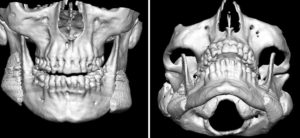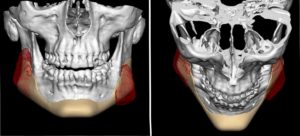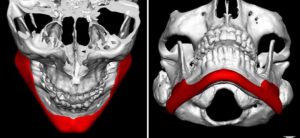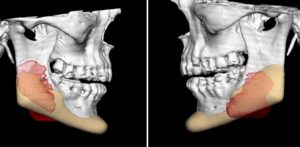Background: The value of jaw angle implants has come into more common use as more complete jawline augmentation effects are sought today from both men and women. Unlike the more well known chin implant, jaw angle implants pose different challenges in both implant style and size selection as well as surgical placement. One could argue that they are doubly difficult over a chin implant because there are two of them and not just one.
From the perspective of being a paired facial implant, jaw angle implants have the potential postoperative risk of asymmetry. This could occur from how they were surgically placed to innate differences in the patient’s jaw angle shapes when standard implants are used. Such a postoperative risk is not rare and in my experience can occur up to 25% of the time. How significant it is and whether the patient is bothered enough by it to undergo a revisional surgery for its improvement is variable.
When faced with jaw angle implant asymmetry I would highly advise getting a 3D CT scan to determine the exact implant positioning on the bone. This has merit in determining how to reposition the ‘bad’ implant’ as well as determining if a completely new approach to the jawline augmentation should be done.
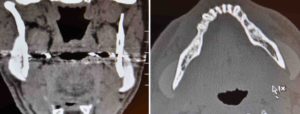
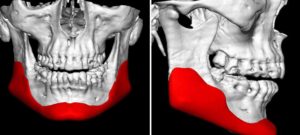
Under general anesthesia and through a three incision approach (external submental and intraoral posterior vestibular), the silicone jaw angle implants were removed and a new complete custom jawline implant placed.
With almost any facial implant asymmetry, the ideal assessment is to get a postoperative 3D CT scan. Using one’s eye to reposition an asymmetric and misplaced implant is an ideate approach in most cases. Having a 3D appreciation of where jaw angle implants are positioned in particular is challenging due to their posterior facial positioning and thick soft tissue cover. But when one does not like the effect of the jaw augmentation, regardless of the asymmetry, such a scan wil provide valuable insight into the secondary approach that is both less likely to be asymmetric as well as creating an improved aesthetic result.
Case Highlights:
1) With the use of standard jaw angle implants, jaw angle asymmetry is a common postoperative occurrence.
2) In some cases a 3D CT scan of the lower jaw can help guide the repositioning the asymmetric jaw angle implant if one of the implants has a good result.
3) But if the jaw angle implants are both asymmetric and do not produce the desired posterior jaw augmentation effect, replacing them with a custom jawline implant would be the preferred secondary treatment approach.
Dr. Barry Eppley
Indianapolis, Indiana



